The Driving Influence of Multi-Dimensional Urbanization on PM2.5 Concentrations in Africa: New Evidence from Multi-Source Remote Sensing Data, 2000–2018
Abstract
:1. Introduction
2. Materials and Methods
2.1. Materials
- (1)
- PM2.5 concentrations. The Atmospheric Composition Analysis Group (ACAG) provided the PM2.5 concentrations (V4.GL.03, 0.05° × 0.05°, Contains “all ingredients”) from the African satellite corrected by geographically weighted regression (GWR) for 1998–2018 (http://fizz.phys.dal.ca/~atmos/martin/?page_id=175) (accessed on 15 December 2020) [26,27]. The mean annual PM2.5 concentration grid data were obtained by vector clipping and calculated using Python 2.7 (http://www.python.org) (accessed on 20 December 2020).
- (2)
- Urbanization. Based on the availability of remote sensing data and existing research, multiple dimensions of urbanization were measured using various indicators, including population urbanization, land urbanization, and economic urbanization [28]. The population urbanization level was depicted by the population density, which was considered to be the most direct indicator of the spatial pattern of population distribution [29]. Its data were obtained from the LandScan Global Population Project, developed by the Department of Energy Oak Ridge National Laboratory (ORNL) in Tennessee, USA based on a combination of geographic information systems, image analysis, and multivariate zoning density models at 1 km spatial resolution (https://www.satpalda.com/product/landscan/) (accessed on 25 December 2020) [30]. The land urbanization level, characterized by the degree of the artificial impervious surface coverage (impervious surface coverage = impervious surface area/total area) [31], was calculated using a 30 m high-resolution artificial impervious surface product by Professor Gong Peng [32]. This product was produced by long-time Landsat optical images (nearly 1.5 million scenes) and other auxiliary data (http://data.ess.tsinghua.edu.cn/) (accessed on 25 December 2020) and has been used in various studies to quantify the expansion intensity of urban areas [33]. For economic urbanization, several studies have shown the feasibility of analyzing regional economic levels using nighttime light intensity [34,35]. Since DMSP/OLS (2000–2013a) and NPP/VIIRS (2013–2018a) are different datasets, continuity correction is required. The global nighttime light dataset (1992–2018a) by Li et al. (2020), accessed from the Scientific Data platform (Nature Group), was used as the data source [36]. In this dataset, a sigmoid function was used to establish the continuity relationship between the DMSP and VIIRS datasets after noise reduction. Given a consistent spatial resolution and radiation characteristics, the performance evaluation showed that the dataset is reliable and can be used stably for long-term global research (https://www.nature.com/articles/s41597-020-0510-y) (accessed on 25 December 2020).
- (3)
- Natural indicators. In addition to urbanization, the agglomeration and diffusion of PM2.5 concentrations have been shown to be highly related to natural factors such as topography, meteorological factors, and vegetation coverage. Xu et al. (2018) concluded that the radiative cooling effect of aerosols caused by low temperatures in winter promotes the accumulation of PM2.5 concentrations [37]. Fang et al. (2020) found that increased forest coverage can reduce PM2.5 concentrations [17]. Zhou et al. (2016) proved that slope and altitude play an important role in blocking PM2.5 pollutants [38]. To reduce omitted variable bias, natural indicators, including normalized differential vegetation index (ndvi), cumulative precipitation (pre), and elevation (ele), were used as control variables in the spatial regression model. As natural control factors, their statistically negative or positive impact would not greatly influence the relationship between urbanization and PM2.5 concentrations. The ndvi data were derived from MODIS monthly NDVI product (MOD13A3-6) at 1 km spatial resolution (https://ladsweb.modaps.eosdis.nasa.gov/search/order/1/MOD13A3-6) (accessed on 5 December 2020). The cumulative precipitation data were obtained from the National Earth System Science Data Center (CN) (http://www.geodata.cn/index.html) (accessed on 5 December 2020), with a spatial resolution of 2.5 points. The elevation and slope data were derived from the GDEMV2 DEM digital elevation product of the Computer Network Information Center of the Chinese Academy of Sciences (http://www.gscloud.cn) (accessed on 5 December 2020) at 30 m spatial resolution and were processed using ArcGIS.
2.2. Methods
2.2.1. Theil–Sen Median Trend Degree
2.2.2. Spatial Autocorrelation Methods
2.2.3. Spatial Regression Analysis
2.2.4. Geographic Detector
2.3. Study Area
3. Results
3.1. Spatio-Temporal Distribution and Spatial Dependence of PM2.5 Concentration and Urbanization under the Rapid Urbanization
3.2. Driving Mechanism of PM2.5 Concentration under the Rapid Urbanization
3.3. Differential Influence and Interaction of Multi-Dimensional Urbanization on PM2.5 Concentrations
4. Discussion
4.1. Explanation for the Different Impact and Interaction Effect of Multi-Dimensional Urbanization on PM2.5 Concentrations
4.2. Policy Implications
- (1)
- Given the strong spillover effects across regions, integrated regional planning in air quality management must be strengthened among African countries. In particular, countries along the Gulf of Guinea and the Sahara Desert should enhance the joint action capacity for air pollution control, monitoring, and mitigation strategies. Developing emission inventories and environmental risk assessment systems within the framework of Agenda 2063 are also critical.
- (2)
- The interaction of multi-dimensional urbanization has a substantial amplifying effect on PM2.5 concentrations. As a result, air quality management in Africa should integrate various urban aspects, such as population lifestyle transformation, land structure optimization, and industrial upgrading. Policymakers should consider comprehensive urban development planning, domestic waste management, urban green space maintenance, and energy conservation, as well as the impact of cross-regional trade on PM2.5 transmission.
- (3)
- Urbanization complexity requires strong sectoral collaboration to effectively manage air pollution. Experiences in PM2.5 governance from other countries should be considered, and governments should promote pollution traceability and accountability. The coordinated management of pollution sources from different sectors should be further strengthened, including those in trade, greening, construction, industrial production, and transportation.
4.3. Research Limitations and Future Directions
5. Conclusions
Author Contributions
Funding
Institutional Review Board Statement
Informed Consent Statement
Data Availability Statement
Conflicts of Interest
References
- Weiss, D.J.; Nelson, A.; Gibson, H.; Temperley, W.; Peedell, S.; Lieber, A.; Hancher, M.; Poyart, E.; Belchior, S.; Fullman, N.; et al. A global map of travel time to cities to assess inequalities in accessibility in 2015. Nat. Cell Biol. 2018, 553, 333–336. [Google Scholar] [CrossRef]
- Esmaeilpoorarabi, N.; Yigitcanlar, T.; Guaralda, M. Place quality in innovation clusters: An empirical analysis of global best practices from Singapore, Helsinki, New York, and Sydney. Cities 2018, 74, 156–168. [Google Scholar] [CrossRef] [Green Version]
- Chen, Y.; Li, X.; Liu, X.; Zhang, Y.; Huang, M. Tele-connecting China’s future urban growth to impacts on ecosystem services under the shared socioeconomic pathways. Sci. Total Environ. 2019, 652, 765–779. [Google Scholar] [CrossRef]
- Gumma, M.K.; Mohammad, I.; Nedumaran, S.; Whitbread, A.; Lagerkvist, C.J. Urban Sprawl and Adverse Impacts on Agricultural Land: A Case Study on Hyderabad, India. Remote. Sens. 2017, 9, 1136. [Google Scholar] [CrossRef] [Green Version]
- Deng, T.; Huang, Y.; Li, Z.; Wang, N.; Wang, S.; Zou, Y.; Yin, C.; Fan, S. Numerical simulations for the sources apportionment and control strategies of PM2.5 over Pearl River Delta, China, part II: Vertical distribution and emission reduction strategies. Sci. Total Environ. 2018, 634, 1645–1656. [Google Scholar] [CrossRef]
- Wang, L.; Liu, Z.; Sun, Y.; Ji, D.; Wang, Y. Long-range transport and regional sources of PM2.5 in Beijing based on long-term observations from 2005 to 2010. Atmos. Res. 2015, 157, 37–48. [Google Scholar] [CrossRef]
- Shi, H.; Wang, S.; Zhao, D. Exploring urban resident’s vehicular PM2.5 reduction behavior intention: An application of the extended theory of planned behavior. J. Clean. Prod. 2017, 147, 603–613. [Google Scholar] [CrossRef]
- Zhang, Q.; Jiang, X.; Tong, D.; Davis, S.; Zhao, H.; Geng, G.; Feng, T.; Zheng, B.; Lu, Z.; Streets, D.G.; et al. Transboundary health impacts of transported global air pollution and international trade. Nature 2017, 543, 705–709. [Google Scholar] [CrossRef] [PubMed] [Green Version]
- Cohen, A.J.; Brauer, M.; Burnett, R.; Anderson, H.R.; Frostad, J.; Estep, K.; Balakrishnan, K.; Brunekreef, B.; Dandona, L.; Dandona, R.; et al. Estimates and 25-year trends of the global burden of disease attributable to ambient air pollution: An analysis of data from the Global Burden of Diseases Study 2015. Lancet 2017, 389, 1907–1918. [Google Scholar] [CrossRef] [Green Version]
- Lelieveld, J.; Evans, J.S.; Fnais, M.; Giannadaki, D.; Pozzer, A. The contribution of outdoor air pollution sources to premature mortality on a global scale. Nature 2015, 525, 367–371. [Google Scholar] [CrossRef] [PubMed]
- Van Stigt, R.; Driessen, P.P.; Spit, T.J. Steering urban environmental quality in a multi-level governance context. How can devolution be the solution to pollution? Land Use Policy 2016, 50, 268–276. [Google Scholar] [CrossRef]
- Shi, C.; Guo, F.; Shi, Q. Ranking effect in air pollution governance: Evidence from Chinese cities. J. Environ. Manag. 2019, 251, 109600. [Google Scholar] [CrossRef]
- Li, C.; Zhang, K.; Dai, Z.; Ma, Z.; Liu, X. Investigation of the Impact of Land-Use Distribution on PM2.5 in Weifang: Seasonal Variations. Int. J. Environ. Res. Public Health 2020, 17, 5135. [Google Scholar] [CrossRef]
- Zhu, W.; Wang, M.; Zhang, B. The effects of urbanization on PM2.5 concentrations in China’s Yangtze River Economic Belt: New evidence from spatial econometric analysis. J. Clean. Prod. 2019, 239, 118065. [Google Scholar] [CrossRef]
- Du, Y.; Wan, Q.; Liu, H.; Liu, H.; Kapsar, K.; Peng, J. How does urbanization influence PM2.5 concentrations? Perspective of spillover effect of multi-dimensional urbanization impact. J. Clean. Prod. 2019, 220, 974–983. [Google Scholar] [CrossRef]
- Wang, Q.; Kwan, M.-P.; Zhou, K.; Fan, J.; Wang, Y.; Zhan, D. The impacts of urbanization on fine particulate matter (PM2.5) concentrations: Empirical evidence from 135 countries worldwide. Environ. Pollut. 2019, 247, 989–998. [Google Scholar] [CrossRef] [PubMed]
- Fang, K.; Wang, T.; He, J.; Wang, T.; Xie, X.; Tang, Y.; Shen, Y.; Xu, A. The distribution and drivers of PM2.5 in a rapidly urbanizing region: The Belt and Road Initiative in focus. Sci. Total Environ. 2020, 716, 137010. [Google Scholar] [CrossRef]
- Du, Y.; Sun, T.; Peng, J.; Fang, K.; Liu, Y.; Yang, Y.; Wang, L. Direct and spillover effects of urbanization on PM 2.5 concentrations in China’s top three urban agglomerations. J. Clean. Prod. 2018, 190, 72–83. [Google Scholar] [CrossRef]
- Wu, C.-D.; Chen, Y.-C.; Pan, W.-C.; Zeng, Y.-T.; Chen, M.-J.; Guo, Y.L.; Lung, S.-C.C. Land-use regression with long-term satellite-based greenness index and culture-specific sources to model PM2.5 spatial-temporal variability. Environ. Pollut. 2017, 224, 148–157. [Google Scholar] [CrossRef] [PubMed]
- Brown, A.M. Sustaining African Cities: Urban Hunger and Sustainable Development in East Africa. Int. J. Environ. Cult. Econ. Soc. Sustain. Annu. Rev. 2015, 11, 1–12. [Google Scholar] [CrossRef]
- Waller, L.A. Estimate suggests many infant deaths in sub-Saharan Africa attributable to air pollution. Nat. Cell Biol. 2018, 559, 188–189. [Google Scholar] [CrossRef] [PubMed]
- Knippertz, P.; Evans, M.J.; Field, P.R.; Fink, A.H.; Liousse, C.; Marsham, J.H.; Evans, M.J. The possible role of local air pollution in climate change in West Africa. Nat. Clim. Chang. 2015, 5, 815–822. [Google Scholar] [CrossRef] [Green Version]
- Keita, S.; Liousse, C.; Yoboué, V.; Dominutti, P.; Guinot, B.; Assamoi, E.-M.; Borbon, A.; Haslett, S.L.; Bouvier, L.; Colomb, A.; et al. Particle and VOC emission factor measurements for anthropogenic sources in West Africa. Atmos. Chem. Phys. Discuss. 2018, 18, 7691–7708. [Google Scholar] [CrossRef] [Green Version]
- Zeng, L.; Offor, F.; Zhan, L.; Lyu, X.; Liang, Z.; Zhang, L.; Wang, J.; Cheng, H.; Guo, H. Comparison of PM2.5 pollution between an African city and an Asian metropolis. Sci. Total Environ. 2019, 696, 134069. [Google Scholar] [CrossRef]
- DeGhetto, K.; Gray, J.R.; Kiggundu, M.N. The African Union’s Agenda 2063: Aspirations, Challenges, and Opportunities for Management Research. Afr. J. Manag. 2016, 2, 93–116. [Google Scholar] [CrossRef]
- Van Donkelaar, A.; Martin, R.V.; Li, C.; Burnett, R.T. Regional Estimates of Chemical Composition of Fine Particulate Matter Using a Combined Geoscience-Statistical Method with Information from Satellites, Models, and Monitors. Environ. Sci. Technol. 2019, 53, 2595–2611. [Google Scholar] [CrossRef] [Green Version]
- Hammer, M.S.; Van Donkelaar, A.; Li, C.; Lyapustin, A.; Sayer, A.M.; Hsu, N.C.; Levy, R.C.; Garay, M.J.; Kalashnikova, O.V.; Kahn, R.A.; et al. Global Estimates and Long-Term Trends of Fine Particulate Matter Concentrations (1998–2018). Environ. Sci. Technol. 2020, 54, 7879–7890. [Google Scholar] [CrossRef]
- Ding, X.K.; Wang, Y.Q.; Han, Y.G.; Fu, J. Evaluating of net anthropogenic nitrogen inputs and its influencing factors in the Three Gorges Reservoir Area. China Environ. Sci. 2020, 40, 206–216. (In Chinese) [Google Scholar] [CrossRef]
- Peng, J.; Tian, L.; Liu, Y.; Zhao, M.; Hu, Y.; Wu, J. Ecosystem services response to urbanization in metropolitan areas: Thresholds identification. Sci. Total Environ. 2017, 607–608, 706–714. [Google Scholar] [CrossRef] [PubMed]
- You, Z.; Feng, Z.; Lei, Y.; Yang, Y.; Li, F. Regional Features and National Differences in Population Distribution in China’s Border Regions (2000–2015). Sustainability 2017, 9, 336. [Google Scholar] [CrossRef] [Green Version]
- Li, M.; Zang, S.; Wu, C.; Na, X. Spatial and temporal variation of the urban impervious surface and its driving forces in the central city of Harbin. J. Geogr. Sci. 2018, 28, 323–336. [Google Scholar] [CrossRef] [Green Version]
- Gong, P.; Li, X.; Wang, J.; Bai, Y.; Chen, B.; Hu, T.; Liu, X.; Xu, B.; Yang, J.; Zhang, W.; et al. Annual maps of global artificial impervious area (GAIA) between 1985 and 2018. Remote. Sens. Environ. 2020, 236, 111510. [Google Scholar] [CrossRef]
- Li, X.; Gong, P.; Zhou, Y.; Wang, J.; Bai, Y.; Chen, B.; Hu, T.; Xiao, Y.; Xu, B.; Yang, J.; et al. Mapping global urban boundaries from the global artificial impervious area (GAIA) data. Environ. Res. Lett. 2020, 15, 094044. [Google Scholar] [CrossRef]
- Zhao, M.; Cheng, W.; Zhou, C.; Li, M.; Wang, N.; Liu, Q. GDP Spatialization and Economic Differences in South China Based on NPP-VIIRS Nighttime Light Imagery. Remote. Sens. 2017, 9, 673. [Google Scholar] [CrossRef] [Green Version]
- Zeng, B. Spatial pattern evolution and influencing factors of county-level economy of border regions in Hunan-Hubei-Jiangxi based on nighttime light data. Sci. Geogr. Sin. 2020, 40, 900–907. (In Chinese) [Google Scholar] [CrossRef]
- Li, X.; Zhou, Y.; Zhao, M.; Zhao, X. A harmonized global nighttime light dataset 1992–2018. Sci. Data 2020, 7, 168. [Google Scholar] [CrossRef]
- Xu, Y.; Xue, W.; Lei, Y.; Zhao, Y.; Cheng, S.; Ren, Z.; Huang, Q. Impact of Meteorological Conditions on PM2.5 Pollution in China during Winter. Atmosphere 2018, 9, 429. [Google Scholar] [CrossRef] [Green Version]
- Zhou, L.; Wu, J.J.; Jia, R.J.; Liang, N.; Zhang, F.Y.; Ni, Y.; Liu, M. Investigation of temporal-spatial characteristics and underlying risk factors of PM2.5 pollution in Beijing-Tianjin- Hebei Area. Res. Environ. Sci. 2016, 29, 483–493. [Google Scholar] [CrossRef]
- Hu, Y.; Xu, J.; Huang, Y.; Zhou, Y.; Pang, Y.; Shi, Z.; Chen, X. Spatial and Temporal Variations in the Rainy Season Onset over the Qinghai–Tibet Plateau. Water 2019, 11, 1960. [Google Scholar] [CrossRef] [Green Version]
- Ghodousi, M.; Sadeghi-Niaraki, A.; Rabiee, F.; Choi, S.-M. Spatial-Temporal Analysis of Point Distribution Pattern of Schools Using Spatial Autocorrelation Indices in Bojnourd City. Sustainability 2020, 12, 7755. [Google Scholar] [CrossRef]
- Walter, M.; Mondal, P. A Rapidly Assessed Wetland Stress Index (RAWSI) Using Landsat 8 and Sentinel-1 Radar Data. Remote. Sens. 2019, 11, 2549. [Google Scholar] [CrossRef] [Green Version]
- Lou, M.; Zhang, H.; Lei, X.; Li, C.; Zang, H. Spatial Autoregressive Models for Stand Top and Stand Mean Height Relationship in Mixed Quercus mongolica Broadleaved Natural Stands of Northeast China. Forests 2016, 7, 43. [Google Scholar] [CrossRef] [Green Version]
- Feng, Y.; Wang, X. Effects of urban sprawl on haze pollution in China based on dynamic spatial Durbin model during 2003–2016. J. Clean. Prod. 2020, 242, 118368. [Google Scholar] [CrossRef]
- Wang, J.F.; Xu, C.D. Geographic detector: Principle and Prospect. Acta Geogr. Sinica 2017, 72, 116–134. (In Chinese) [Google Scholar] [CrossRef]
- Wang, H.; Gao, J.; Hou, W. Quantitative attribution analysis of soil erosion in different geomorphological types in karst areas: Based on the geodetector method. J. Geogr. Sci. 2019, 29, 271–286. [Google Scholar] [CrossRef] [Green Version]
- Yatta, F.P. Urbanization in Africa: Trends, Regional Specificities, and Challenges. Advances in Geographical and Environmental Sciences; Springer: Berlin, Germany, 2018; pp. 317–339. [Google Scholar] [CrossRef]
- Maingi, S.W. Sustainable tourism certification, local governance and management in dealing with overtourism in East Africa. Worldw. Hosp. Tour. Themes 2019, 11, 532–551. [Google Scholar] [CrossRef]
- Li, Y.; Xue, Y.; Guang, J.; de Leeuw, G.; Self, R.; She, L.; Fan, C.; Xie, Y.; Chen, G. Spatial and temporal distribution characteristics of haze days and associated factors in China from 1973 to 2017. Atmos. Environ. 2019, 214, 116862. [Google Scholar] [CrossRef]
- Chen, H.; Li, L.; Lei, Y.; Wu, S.; Yan, D.; Dong, Z. Public health effect and its economics loss of PM2.5 pollution from coal consumption in China. Sci. Total Environ. 2020, 732, 138973. [Google Scholar] [CrossRef]
- Mijiyawa, A.G. Drivers of Structural Transformation: The Case of the Manufacturing Sector in Africa. World Dev. 2017, 99, 141–159. [Google Scholar] [CrossRef] [Green Version]
- Roy, R. The cost of air pollution in Africa. In OECD Development Centre Working Papers; OECD Publishing: Paris, France, 2016. [Google Scholar] [CrossRef]
- Tumwesige, V.; Okello, G.; Semple, S.; Smith, J. Impact of partial fuel switch on household air pollutants in sub-Sahara Africa. Environ. Pollut. 2017, 231, 1021–1029. [Google Scholar] [CrossRef]
- Jiang, Z.; Cheng, H.; Zhang, P.; Kang, T. Influence of urban morphological parameters on the distribution and diffusion of air pollutants: A case study in China. J. Environ. Sci. 2021, 105, 163–172. [Google Scholar] [CrossRef]
- Zhao, H.Y.; Zhang, Q.; Guan, D.; Davis, S.; Liu, Z.; Huo, H.; Lin, J.T.; Liu, W.D.; He, K.B. Assessment of China’s virtual air pollution transport embodied in trade by using a consumption-based emission inventory. Atmos. Chem. Phys. 2015, 15, 5443–5456, Atmos. Chem. Phys. Discuss.2015, 15, 6815. [Google Scholar] [CrossRef] [Green Version]
- Azarmi, F.; Kumar, P.; Marsh, D.; Fuller, G. Assessment of the long-term impacts of PM10and PM2.5particles from construction works on surrounding areas. Environ. Sci. Process. Impacts 2015, 18, 208–221. [Google Scholar] [CrossRef] [Green Version]
- Zhou, X.; Wang, Y.-C. Spatial–temporal dynamics of urban green space in response to rapid urbanization and greening policies. Landsc. Urban Plan. 2011, 100, 268–277. [Google Scholar] [CrossRef]
- Sun, Y.; Xie, S.; Zhao, S. Valuing urban green spaces in mitigating climate change: A city-wide estimate of aboveground carbon stored in urban green spaces of China’s Capital. Glob. Chang. Biol. 2019, 25, 1717–1732. [Google Scholar] [CrossRef]
- Li, Y.; Schubert, S.; Kropp, J.P.; Rybski, D. On the influence of density and morphology on the Urban Heat Island intensity. Nat. Commun. 2020, 11, 1–9. [Google Scholar] [CrossRef]
- He, S.W.; Shao, X. Spatial Clustering and Coupling Coordination of Population-Land-Economic Urbanization in Beijing-Tianjin-Hebei Region. Econ. Geogr. 2018, 38, 95–102. (In Chinese) [Google Scholar] [CrossRef]
- Liu, Y.; Zhou, G.; Liu, D.; Yu, H.; Zhu, L.; Zhang, J. The Interaction of Population, Industry and Land in Process of Urbanization in China: A Case Study in Jilin Province. Chin. Geogr. Sci. 2018, 28, 529–542. [Google Scholar] [CrossRef] [Green Version]
- Aboubacar, B.; Deyi, X.; Razak, M.Y.A.; Leyla, B.H. The Effect of PM2.5 from Household Combustion on Life Expectancy in Sub-Saharan Africa. Int. J. Environ. Res. Public Health 2018, 15, 748. [Google Scholar] [CrossRef] [Green Version]
- Rushingabigwi, G.; Nsengiyumva, P.; Sibomana, L.; Twizere, C.; Kalisa, W. Analysis of the atmospheric dust in Africa: The breathable dust’s fine particulate matter PM2.5 in correlation with carbon monoxide. Atmos. Environ. 2020, 224, 117319. [Google Scholar] [CrossRef]



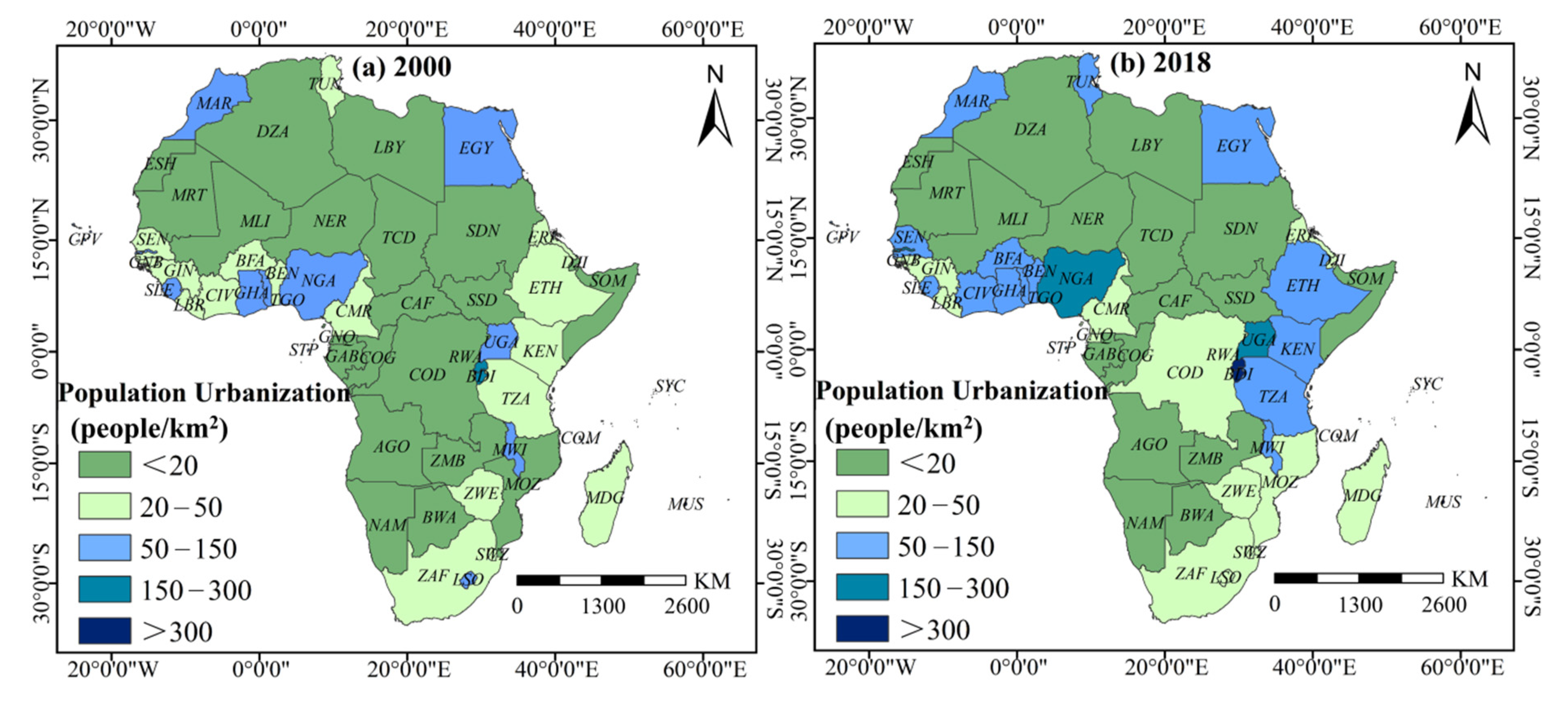
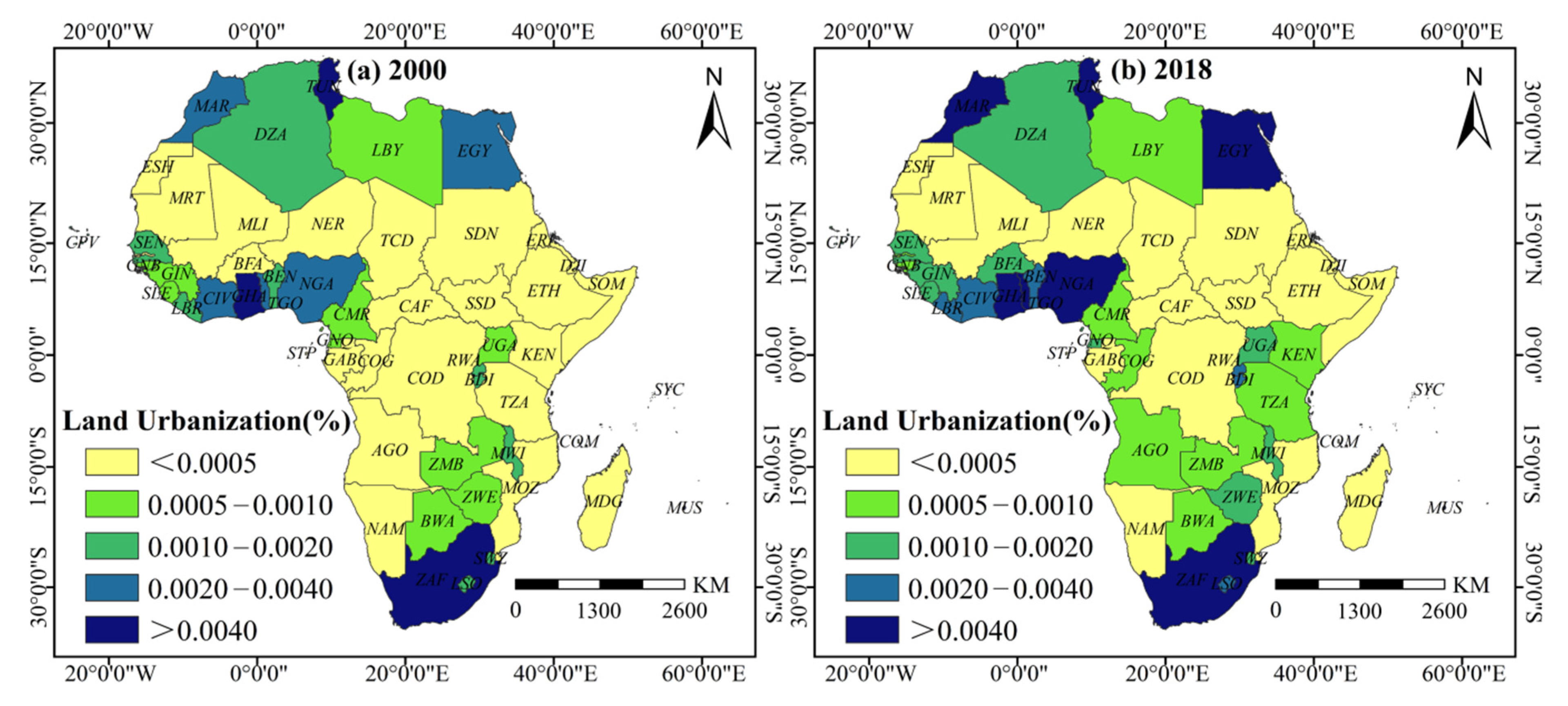

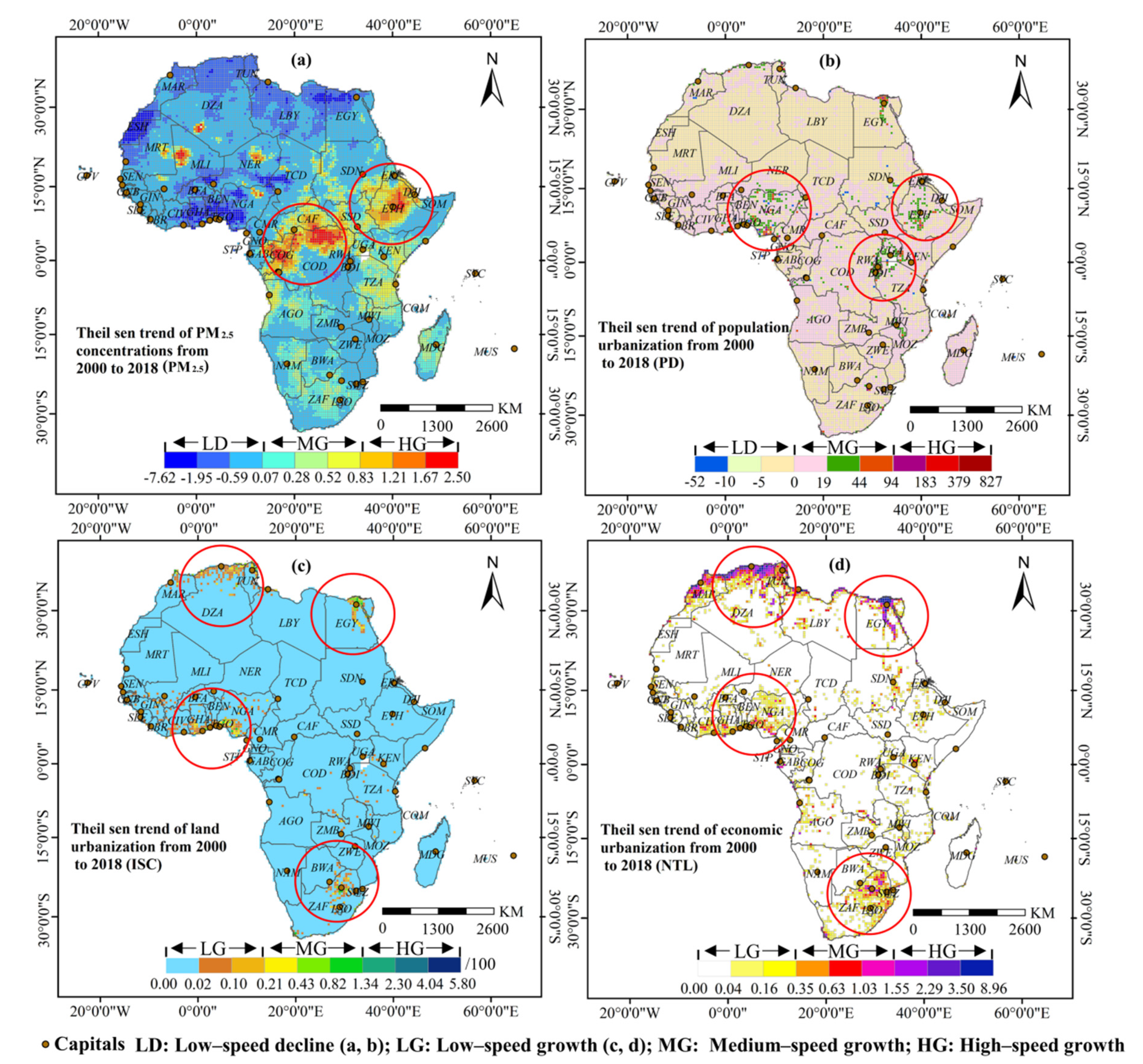
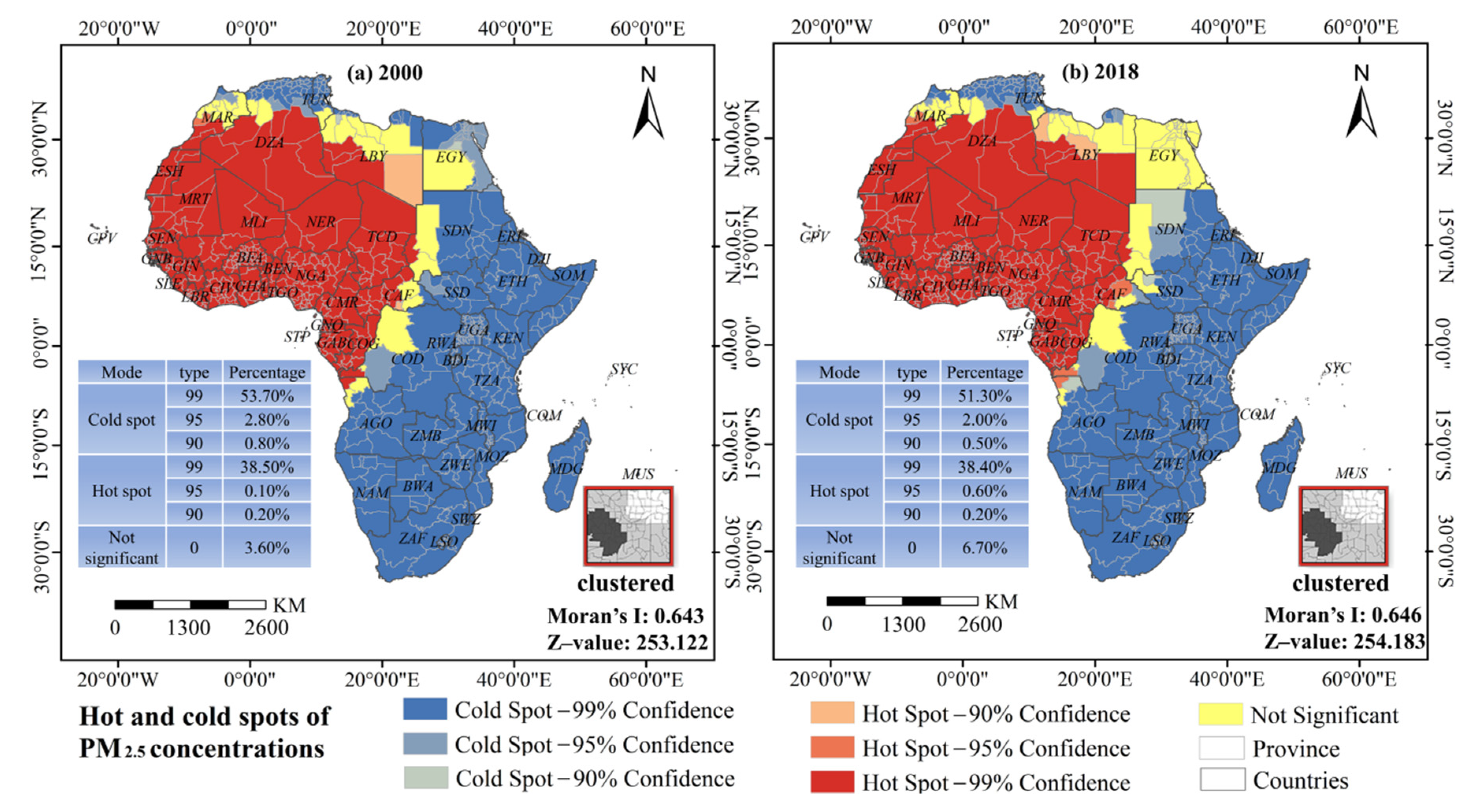

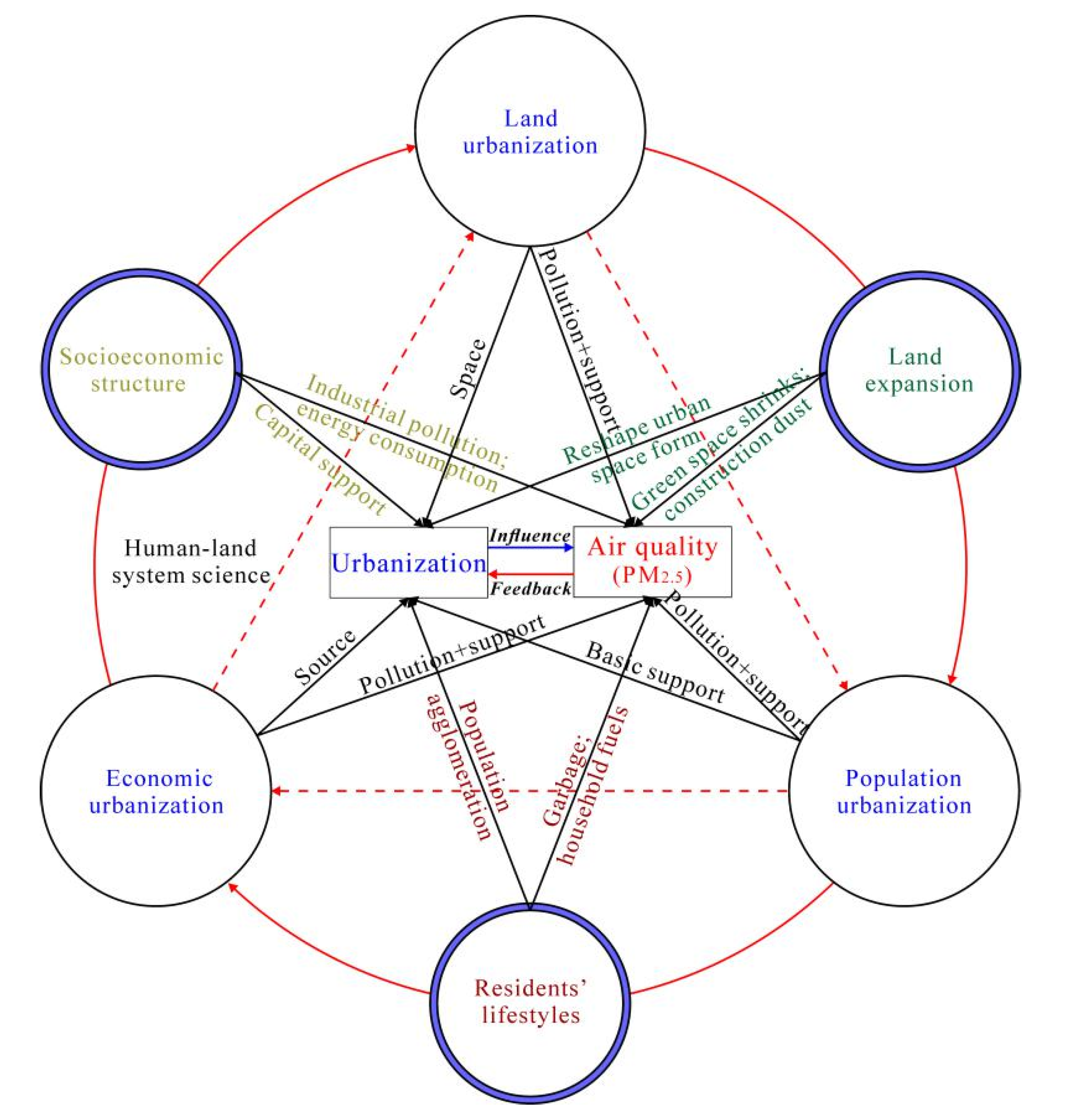
| Variable Category | Variable | Abbreviation | Measurement Unit |
|---|---|---|---|
| Urbanization | Population density | pd | people/km2 |
| Impervious surface coverage | isc | % | |
| Nighttime light intensity | ntl | DN | |
| Natural variable | PM2.5 concentrations | PM2.5 | μg/m3 |
| Normalized differential vegetation index | ndvi | - | |
| Cumulative precipitation | pre | mm | |
| Elevation | ele | m | |
| Slope | slope | - |
| Interaction | Judgment Basis |
|---|---|
| Non-linear reduction | P(A∩B) < min(P(A),P(B)) |
| Single-factor nonlinearity reduction | min(P(A),P(B)) < P(A∩B) < max(P(A),P(B)) |
| Two-factor enhancement | P(A∩B) > max(P(A),P(B)) |
| Independent | P(A∩B) = P(A) + P(B) |
| Non-linear enhancement | P(A∩B) > P(A) + P(B) |
| Regions | Countries and Regions |
|---|---|
| Northern Africa | Egypt, Libya, Tunisia, Algeria, Morocco, Sudan, Western Sahara |
| Eastern Africa | Eritrea, Ethiopia, South Sudan, Djibouti, Somalia, Kenya, Uganda, Rwanda, Burundi, Tanzania, Madagascar, Zambia, Zimbabwe, Malawi, Mozambique, Seychelles, Mauritius, Comoros |
| Western Africa | Nigeria, Benin, Ghana, Togo, Côte d’Ivoire, Liberia, Sierra Leone, Guinea, Guinea-Bissau, Senegal, Gambia, Mauritania, Mali, Niger, Cape Verde, Burkina Faso |
| Central Africa | Angola, Congo, Congo Dem.Republic, Equatorial Guinea, Gabon, Central African Republic, Chad, Cameroon, Sao Tome and Principe |
| Southern Africa | Botswana, Namibia, South Africa, Swaziland, Lesotho |
| Variables | SDM_2000 | SDM_2010 | SDM_2018 |
|---|---|---|---|
| lncmpu | 0.051 *** | 0.054 *** | 0.097 *** |
| lnndvi | −0.022 *** | −0.037 *** | −0.041 *** |
| lnpre | −0.017 *** | −0.007 * | 0.015 ** |
| lnele | −0.03 *** | −0.018 *** | −0.034 *** |
| lnslope | −0.038 *** | −0.062 *** | −0.060 *** |
| W*cmpu | 0.068 *** | 0.099 ** | 0.122 * |
| W*ndvi | 0.014 *** | 0.024 *** | 0.020 *** |
| W*pre | 0.042 *** | 0.038 *** | 0.031 *** |
| W*ele | 0.012 *** | 0.014 *** | 0.028 *** |
| W*slope | −0.050 *** | −0.018 *** | −0.033 *** |
| R-squared | 0.961 (SLM) | 0.956 (SLM) | 0.954 (SLM) |
| 0.961 (SEM) | 0.956 (SEM) | 0.955 (SEM) | |
| 0.962 (SDM) | 0.956 (SDM) | 0.957 (SDM) | |
| Log-L | 24,236.9 (SLM) | 24,428.8 (SLM) | 24,343.7 (SLM) |
| 24,142.9 (SEM) | 24,382.1 (SEM) | 24,267.9 (SEM) | |
| 24,273.9 (SDM) | 24,467.1 (SDM) | 24,384.3 (SDM) | |
| LR-SLM | 38,347.6 *** | 34,852.9 *** | 34,948.5 *** |
| LR-SEM | 38,159.6 *** | 34,759.6 *** | 34,797.1 *** |
| Row Number | Type of Urbanization | Variable | Indicator Abbreviation | Direct Effect (DEU) | Spillover Effect (SEU) | ||||
|---|---|---|---|---|---|---|---|---|---|
| 2000 | 2010 | 2018 | 2000 | 2010 | 2018 | ||||
| 1 | Population urbanization | Population density | lnpd | −0.005 (−0.410) | −0.001 (−0.147) | −0.002 (−0.224) | −0.251 (−0.399) | −0.783 (−1.511) | −0.265 (−0.512) |
| 2 | Land urbanization | Impervious surface coverage | lnisc | 0.015 * (1.909) | 0.030 *** (4.174) | 0.026 *** (2.325) | −1.015 *** (−2.325) | 0.406 (0.966) | −0.459 (−0.682) |
| 3 | Economic urbanization | Nighttime light intensity | lnntl | 0.020 *** (4.225) | 0.017 *** (4.007) | 0.027 *** (5.671) | 1.241 *** (3.103) | 1.587 *** (3.684) | 2.464 *** (4.228) |
| Year | P1 = A∩B | P2 = A + B | Comparison Result | Interaction Types |
|---|---|---|---|---|
| 2000 | PU∩LU = 0.07 | P(0.003) + LU(0.029) = 0.032 | P > PU + LU | Nonlinear enhancement |
| PU∩EU = 0.12 | PU(0.003) + EU(0.07) = 0.073 | P > PU + EU | Nonlinear enhancement | |
| LU∩EU = 0.14 | LU(0.029) + EU(0.07) = 0.099 | P > LU + EU | Nonlinear enhancement | |
| 2010 | PU∩LU = 0.11 | PU(0.009) + LU(0.031) = 0.04 | P > PU + LU | Nonlinear enhancement |
| PU∩EU = 0.21 | PU(0.009) + EU(0.08) = 0.017 | P > PU + EU | Nonlinear enhancement | |
| LU∩EU = 0.11 | LU(0.031) + EU(0.08) = 0.039 | P > LU + EU | Nonlinear enhancement | |
| 2018 | PU∩LU = 0.09 | PU(0.005) + LU(0.017) = 0.022 | P > PU + LU | Nonlinear enhancement |
| PU∩EU = 0.63 | PU(0.005) + EU(0.42) = 0.425 | P > PU + EU | Nonlinear enhancement | |
| LU∩EU = 0.46 | L(0.017) + EU(0.42) = 0.437 | P > LU + EU | Nonlinear enhancement |
Publisher’s Note: MDPI stays neutral with regard to jurisdictional claims in published maps and institutional affiliations. |
© 2021 by the authors. Licensee MDPI, Basel, Switzerland. This article is an open access article distributed under the terms and conditions of the Creative Commons Attribution (CC BY) license (https://creativecommons.org/licenses/by/4.0/).
Share and Cite
Wei, G.; Sun, P.; Jiang, S.; Shen, Y.; Liu, B.; Zhang, Z.; Ouyang, X. The Driving Influence of Multi-Dimensional Urbanization on PM2.5 Concentrations in Africa: New Evidence from Multi-Source Remote Sensing Data, 2000–2018. Int. J. Environ. Res. Public Health 2021, 18, 9389. https://doi.org/10.3390/ijerph18179389
Wei G, Sun P, Jiang S, Shen Y, Liu B, Zhang Z, Ouyang X. The Driving Influence of Multi-Dimensional Urbanization on PM2.5 Concentrations in Africa: New Evidence from Multi-Source Remote Sensing Data, 2000–2018. International Journal of Environmental Research and Public Health. 2021; 18(17):9389. https://doi.org/10.3390/ijerph18179389
Chicago/Turabian StyleWei, Guoen, Pingjun Sun, Shengnan Jiang, Yang Shen, Binglin Liu, Zhenke Zhang, and Xiao Ouyang. 2021. "The Driving Influence of Multi-Dimensional Urbanization on PM2.5 Concentrations in Africa: New Evidence from Multi-Source Remote Sensing Data, 2000–2018" International Journal of Environmental Research and Public Health 18, no. 17: 9389. https://doi.org/10.3390/ijerph18179389
APA StyleWei, G., Sun, P., Jiang, S., Shen, Y., Liu, B., Zhang, Z., & Ouyang, X. (2021). The Driving Influence of Multi-Dimensional Urbanization on PM2.5 Concentrations in Africa: New Evidence from Multi-Source Remote Sensing Data, 2000–2018. International Journal of Environmental Research and Public Health, 18(17), 9389. https://doi.org/10.3390/ijerph18179389











